Scenes From a Milonga
Navigation is a difficult subject. The problem is that after you cover a few general rules, it can easily degenerate into a cranky guy (me) telling story after story about bad dancers. It's tempting to go in that direction—I have enough stories just from the past week alone to fill up the page. But I'm sure most of you have plenty of stories of your own, so I won't bore you with mine. Instead, I'll continue working on my Photoshop skills, and make some more diagrams. (That Pen Tool is driving me crazy). Then, on the next page, we'll present some drills for pivoting and turning that people can use to help curve the paths of their tango dancing.
Here's the first diagram. It shows a medium-crowded milonga surrounded by blue tables, and there are two lanes painted on the floor in light yellow. The dark grey line represents the path one of the couples has taken. The question is, did they do anything wrong?
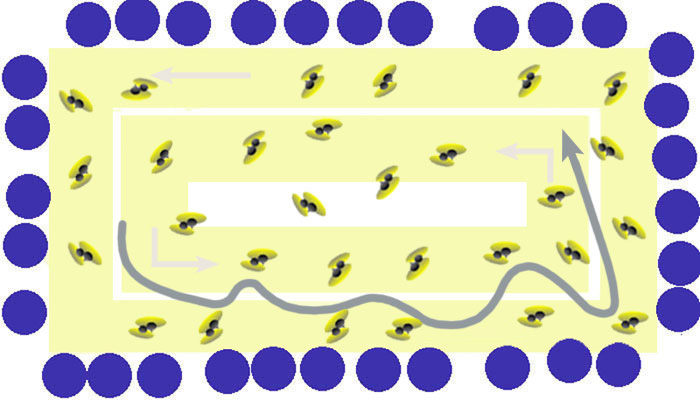
This is one of the two most common navigation mistakes. This couple's path wanders along, straddling the border between the inner and outer lanes of traffic. Instead of being in one of the two rondas, they split the difference and drift from one to the other. They squeeze between dancers like a motorbike squeezing between lanes of traffic. If you look closely, you'll see that they have bothered at least seven other couples (outlined in red, below). They've forced a couple of people up against the tables, and made a general nuisance of themselves. (Actually, of himself, because it's the man who's driving.):
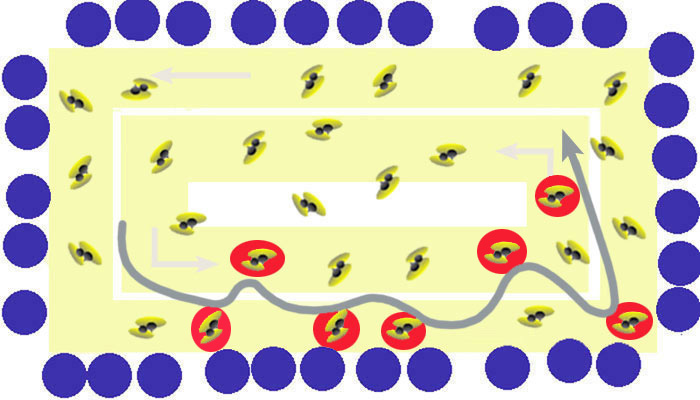
This couple is straddling and wandering, and making a nuisance of themselves.
Like most bad navigation, it's pointless. Although in the diagram it may look like the lane-straddler is passing people, in reality they usually just drift along with everyone else, and randomly bump up against other couples. What are lane-straddlers thinking? Hard to know. It's not an easy way to dance, but they show up all the time in milongas. It may be nothing more than seeing a little open space between the two rondas, and being attracted to it. Or maybe not realizing that lanes exist, and having a compulsive urge to pass people.
How about the situation below? Do you see anything wrong with the path of this couple?
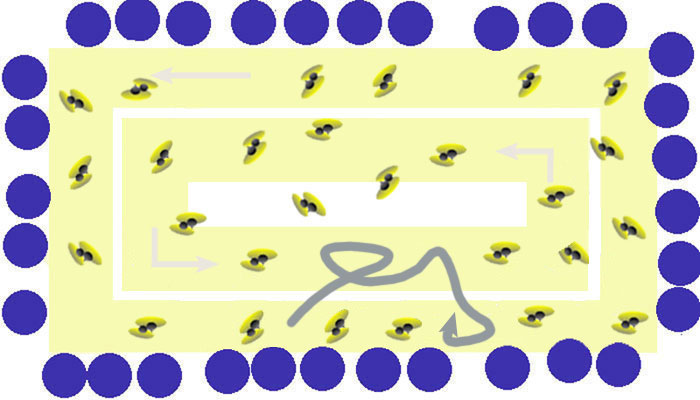
This couple was getting squeezed, so they moved into the inner ronda to look for more space.
For me, no. This couple was in a bit of a squeeze in the ronda, with a pusher behind them, and a dawdler two couples ahead. So they slipped into the next lane, worked their way forward, and returned to the outer ronda when they found available space. By doing so, they helped themselves, and everyone else. They relieved a little of the congestion behind the dawdler, and moved into unused space on the floor. This is an example of how good navigation helps everyone. (Note that no one in the paths of these diagrams is moving quickly. We're assuming they are dancing smoothly in a normal manner. They may sometimes move a little faster than the general, counter-clockwise drift of the floor, but they aren't running or taking huge steps.)
Here's another situation:
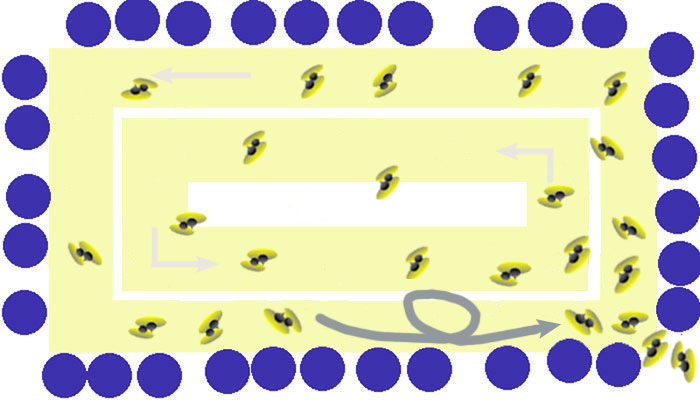
This is one of the worst navigation mistakes, and it happens all the time. The grey line represents the path of a couple that can't keep from closing the gap, and they are pushing up against the couple ahead of them. The couple in red, (below), are their victims.
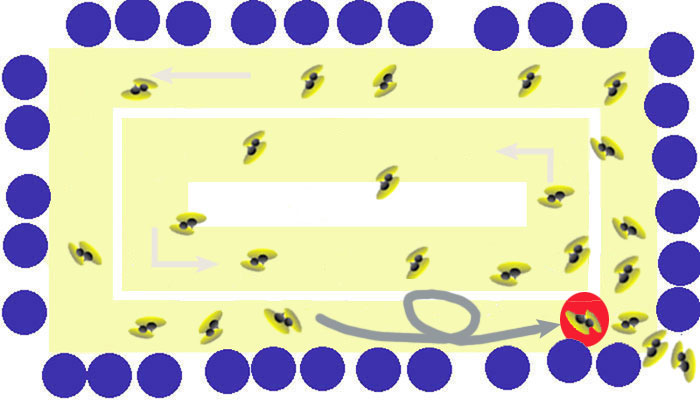
Pushing up against the couple ahead when they can't move is just... stupid.
Often, during the first tango of a tanda, traffic backs up in places where couples enter the floor (lower right corner). They have the right to enter, and the only solution is for the ronda to stop its forward motion, until the new dancers can disperse onto the floor. But sometimes, people can't resist the urge to continue forward. Here, the couple in red is trying to dance in place, until the floor clears ahead, but the they are being pushed into the crowd in the corner by the couple behind. The solution is simple. If you see things backing up ahead of you in the ronda, don't move forward anymore. Continue to split the difference between the couple ahead and behind, but hold your position—dance in place until things begin to move again. Or escape into the middle of the floor and look for free space.
What about the paths these two couples are taking?
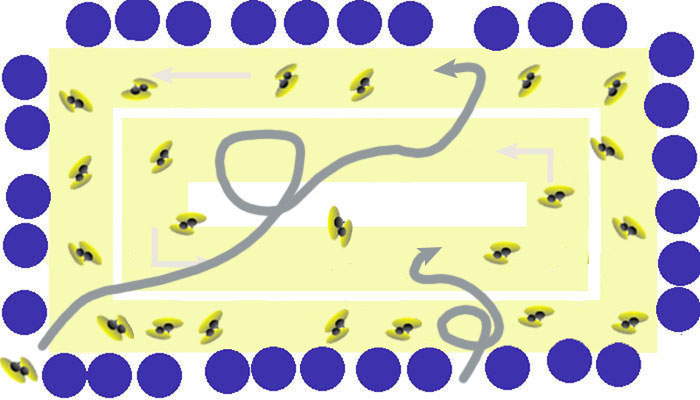
These paths show a couple of ways to enter the floor.
I think they're okay. The couple on the left entered from the corner, and instead of hanging around and trying to dance where things are jammed up, they moved out into the floor to look for space in the ronda. The other couple entered from between the tables, which they have the right to do, and chose to move across into the inner ronda. But what about the fact that the first couple went in the wrong direction (red arrow below)?
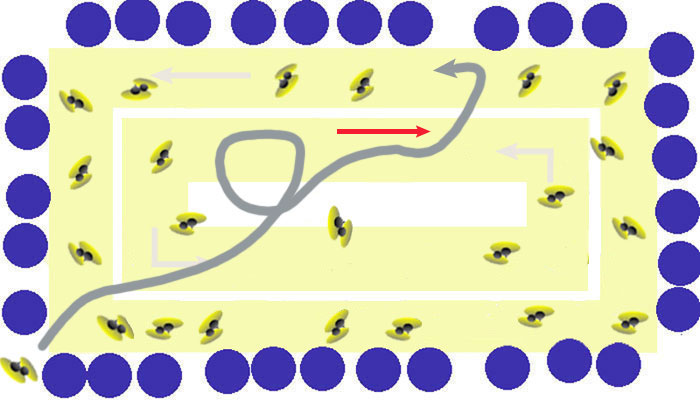
If there's no one around, go anywhere you want, in any direction you want.
No big deal. I don't see anything wrong with moving against the line of dance in the ronda if no one is there. In fact, when dancing in the ronda, we continually move front and back within our shared space, if there's room.
By the way, this couple is doing something that Alej and I often do. You might call it "forum shopping" (a term lawyers use that means trying to get into the courtroom of a sympathetic judge). If they know the other dancers, this couple may have taken this path to look for a place in the ronda between two couples they're familiar with.
Dancing between two smooth, rhythmic couples that know what they're doing is a nice place to be. It helps you avoid pushers, dawdlers, and people who are careless or unpredictable. This may not be well known, but it's one of the great advantages of being a polite, controlled dancer in BsAs. If you dance carefully, the milongueros will get to know you, and they'll make space for you, or they'll slip in front or behind you in the ronda.
When I began to be very careful about my navigation, I started to notice that some good milongueros were often dancing close to Alej and me. After a while I realized that careful dancers tend to group together to make it easier for each other. This is something for people to think about who are concerned with making an impression with their dancing. The way to find true respect and acceptance is to master the art of floor navigation. The best dancers in BsAs are always very aware of the way other people are dancing, and if they respect you, they will begin to seek you out and make a little extra room for you. (The same thing applies to the pecking order in bike racing. The best riders will let good bike handlers close to them in the peloton, and make life difficult for careless riders.)
How about this guy:
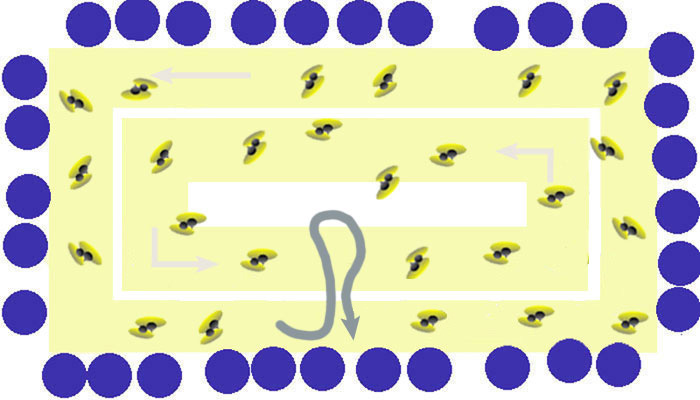
Good dancers often take advantage of free space outside of the ronda.
This is okay. It's something good dancers do all the time. The rules aren't made to handcuff people. If there's free space, and you can use it without bothering anyone else, go for it. Step large if you want to. In a sense, it actually helps the milonga, because it's an efficient use of the floor. This couple saw unused space in the inner ronda, and the middle of the floor, and took a brief trip into it, and back. The couples ahead and behind them in the ronda should be aware that dancers sometimes do this, and leave the space open for them for several beats of the compás, in case they want to return. The lanes and direction of rotation exist to prevent conflicts, but if no one's around, you can go pretty much wherever you want.
How about the next situation:
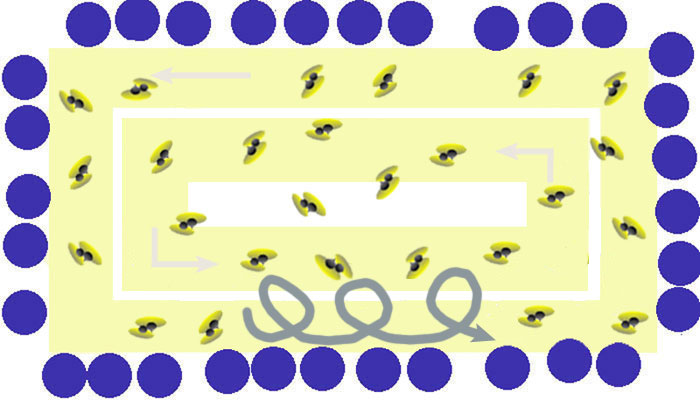
This is very bad—and very common. The couple in this diagram is "dancing large". They're curving their dancing, but they are also taking big, lunging steps, that cause their dancing to be wider than the ronda, and spill into the next lane. This kind of dancing sometimes occurs in the inner lane, and the middle of the floor as well, with people taking large steps and making large giros that spill over and bother people in other lanes. You don't always have to stay in your lane if there's room (previous example), but you should never push up against couples in the next lane (in red below).
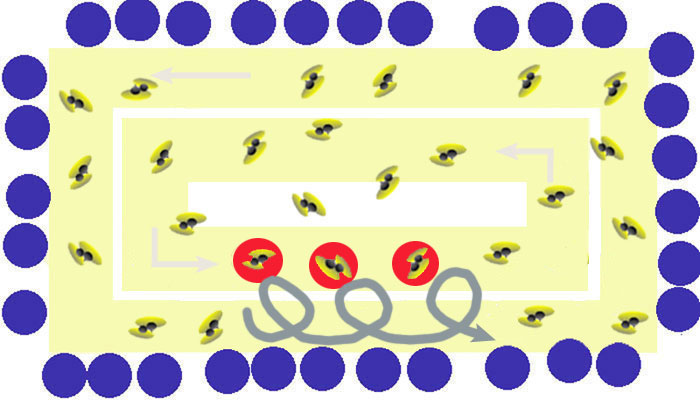
Very bad, and very selfish. People who can't dance within their space shouldn't go to milongas.
If you must dance this way, go very early and get it out of your system before other people show up—or go to a practica.
What about the diagram below?
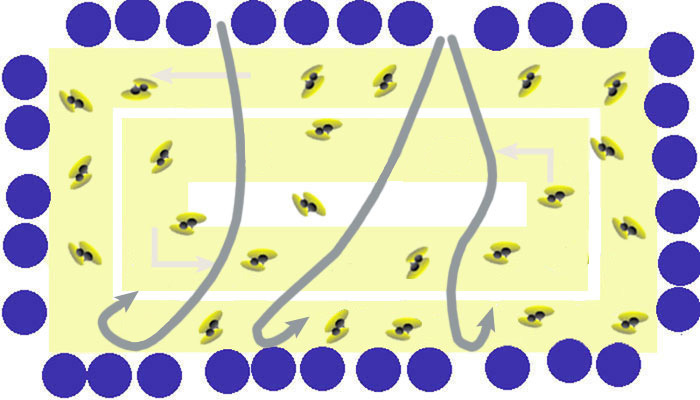
One of the necessities of a crowded milonga: men crossing the floor to pick up their partners.
Maybe sort of a trick question. These lines represent men who are walking across the floor to pick up their partners. In most milongas, men and women face each other, and after connecting with the cabeceo, men usually walk between other dancers to look for their partners. If you're dancing, you should be aware of it, and you should let them into the ronda in front of you. If you're picking up your partner, remember the dancers on the floor have the right-of way, and they may not be expecting you to walk up behind them. Several times I've taken a back step and almost collided with a man crossing the floor who appeared out of nowhere, so never walk right behind a man who's dancing. And look for a gap in the ronda along the tables when you pick up the woman, and begin to dance.
One way to think about the pista is to visualize three kinds of space. The first is the personal space that surrounds every couple. It usually extends out about a medium-sized step in every direction. No one should ever enter it. The second kind of space is the most complicated. It is "shared space", and I've represented it below in light blue:
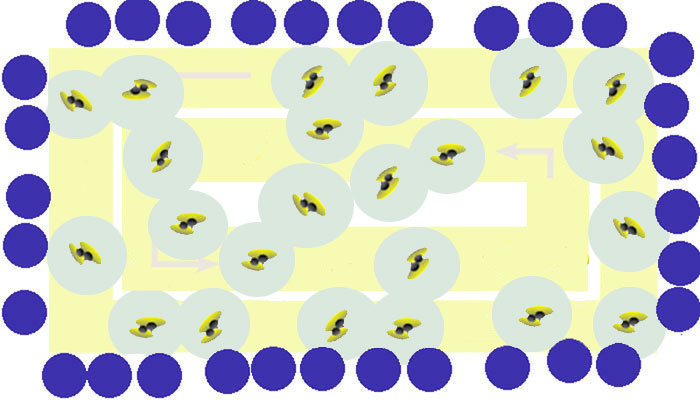
The light blue circles surrounding these couples represent "shared space".
You have the sole and absolute right to dance within your own personal space (the red areas below), but shared space is more complicated. For now, let's say it extends out from each couple about three medium-sized steps, or maybe two or three beats of the compás on a crowded floor. You can move in and out of shared space as you dance, but you need to be alert to what the couples around you are doing. If you sense another couple is also moving in your direction into the space, you may need to stop, or turn to avoid them. You need to continually monitor the shared space around you to decide which is most available from moment to moment. Dance into it for a couple of beats, and then dance back to center yourself between the couples that surround you.
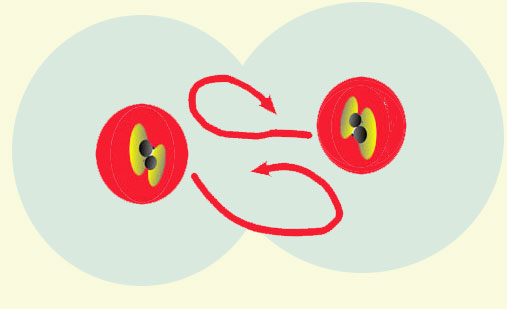
The light blue circles surrounding these couples show "shared space". The red paths
represent acceptable ways of dancing close to other couples, and then returning to center.
Personal space, and the surrounding shared space, aren't stationary. They drift generally counter-clockwise around the floor. While navigating, a dancer is managing several things at once. He's responsible for the micro-management within his own personal space, and the shared space around him. In addition, he needs to drift counter-clockwise, and he should also be aware of any free-spaced that may be nearby. If he senses unused areas on the floor next to him, it's often best to drift into them. The red arrows below represent possible ways couples could drift into free-space to even out the spacing on the floor and relieve crowding:
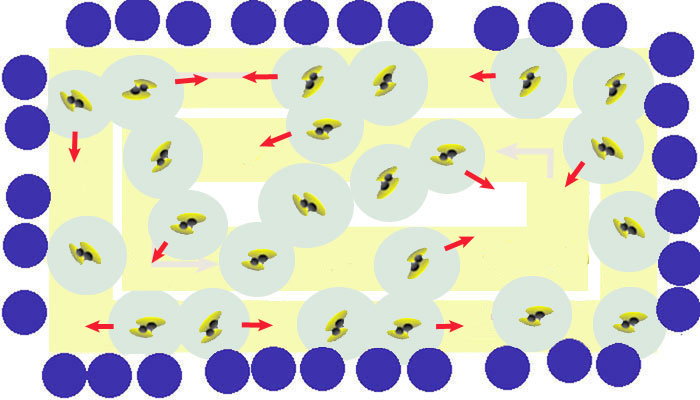
Good dancers monitor both the shared space around them, and the spacing of the entire floor.
The red arrows show different directions couples might move to relieve crowding.
In a good milonga, where people know how to navigate, this drifting into free space and readjusting is constantly taking place. Things may get jammed up a little, but every few beats the floor readjusts itself. There are lots of ways to look at tango videos, but if you look back through many of those posted here, one of the things that's happening is that people are managing their own spaces, and also constantly readjusting the entire floor by instinctively moving into unused space.
The Bratboy Effect
The things we've looked at on this page are part of the codigos of the milongas. We've discussed many of them on this site, but as far as I know, they aren’t written down anywhere else. They've existed for a long time, but no one person made them up. Just like English common law, the codigos came into use among common people because they were needed. At its core, tango is nothing more than people coming together to enjoy the music. That's why the music and words were created. Coming together to dance in milongas is tango. It's the reason tango exists. Without codigos, milongas couldn't exist—and without milongas, there would be no tango.
But today, a revolution is taking place. It's a tango revolution led by people like the fellow we looked at on the Kung Fu Tanda page—and I'll be the first to admit that the revolutionaries are winning. Gustavo Naveira and his clones are traveling the world, and they are wildly popular. Their revolution is based on the idea that the traditions and codigos of tango limit creativity. For them, self-expression is everything. They believe tango should include all kinds of music, and all kinds of movement. Fair enough. Sometimes a revolution is necessary—but every revolution has a price.
Two weeks ago, I happened to notice an announcement for a practica posted on a discussion group in the U.S. It was posted in large letters:
Join us for an evening of authentic Argentine Tango…
Just bring your open mind. Everything goes!
At first, I let it go. But as I began to work on the navigation pages, and think about problems on the dance floor, the phrase "everything goes" used with "authentic Argentine Tango" began to get under my skin. I mean, people have every right to hold "alternative" tango events if they want to—but why did they have to go out of their way to call it "authentic Argentine Tango"? It almost seemed like a deliberate slap in the face. Like they were thumbing their noses at the culture of tango and of Argentina. These are people who don't hesitate to use the music of the Golden Age maestros whenever it suits them to make money for their events. But to then turn around and insult them by calling the "alternative" music they play, and the stunts they picked up somewhere "authentic Argentine Tango"... why would someone do that?
Since the discussion group is in the town where Alej and I live when we're in the U.S., I decided to say something. I wasn't optimistic about what would happen, because the question of putting limits on some of the things people were doing in the local milongas had been raised before by other people on the list, and the responses had included words like "tango police", "rule lovers", and even "tango Nazis". But I went ahead. My post was short and to the point:
I notice you advertised your practica as an evening of "authentic Argentine Tango" where "everything goes." Isn't that a little misleading?
The list in question is pretty sleepy. There are announcements for classes and practicas every few days, but that's about it. The response to my question, however, was swift. Someone who calls himself the "Bratboy of Tango" appeared almost instantly: "Who rattled your cage? Where's a moderator when you need one??"
The people leading the charge for a new tango are polished dancers who know how to express themselves, but people like Bratboy are often the end result of their revolution. They are the kind of people that walk out of their workshops—and into the local milongas. Although part of my disagreement with the announcement was that I don't think people should misrepresent tango just to look for customers, that wasn't the real reason I spoke up. The problem is that if you give new dancers the idea that "authentic Argentine Tango" includes anything and everything, then they'll go through the roof if someone suggests that they can't do whatever they want in a milonga. And if people do whatever they want in a milonga, tango can't exist.
But wait... maybe it can exist! Let's look more closely at what the academic tango revolutionaries are promoting around the world. Let's see what their vision means for the future of tango.
An Upside-Down Revolution
"The men sold you...
betrayed you like Jesus.
Impaled you on the Obelisk...
bleeding you endlessly.
How sad,
because you are ours." -
----------
-Tristezas de la Calle Corrientes
When you think about it, it's a strange revolution. This isn't a political site, but most revolutions occur when a social system becomes frozen, and large numbers of people can't get ahead. The people at the top hold the power and the money, and the ones on the bottom are stuck—hence, people storming the walls of the castle.
But take a look at this new tango revolution. For 100 years tango has been the great leveler in Argentine society. It's the one place where everybody comes together. Rich ladies from Recoleta embrace taxi drivers from Avellaneda. Doctors and lawyers share tables with unemployed carpenters, and dance closely with uneducated people from the poorest parts of town. There is no class system, and no discrimination. Tango is, quite literally, of the people, by the people, and for the people. It's for everyone—and the only thing it asks of us is that we love the music and respect each other. This may not always be obvious to someone who visits BsAs for a few weeks, but the longer I dance, the more I feel the power of the brotherhood and sisterhood of the milongas. It actually does exist, and it reaches across all levels of Argentine society. Alej and I talk about it all the time when we leave the milongas at night—about the beauty of being able to share the music with thousands of people from all over town.
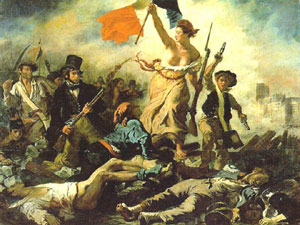 But think for a moment about the vision that the revolutionaries are so aggressively promoting around the world. They have no interest in the old system where people can spend a lifetime learning and sharing the music in milongas. For them, tango consists of high-level workshops and performances—and they are the established stars. The attraction for newcomers is the dream they hold out for the most ambitious students—the vision of someday polishing the steps and figures to the point where students can begin performing and giving classes of their own. And then, the students of the students can dream of doing the same. At its core, their system is a Ponzi scheme. A pyramid of selling that requires a constant influx of new people to buy into the illusions and the steps—all the way down to the Bratboys.
But think for a moment about the vision that the revolutionaries are so aggressively promoting around the world. They have no interest in the old system where people can spend a lifetime learning and sharing the music in milongas. For them, tango consists of high-level workshops and performances—and they are the established stars. The attraction for newcomers is the dream they hold out for the most ambitious students—the vision of someday polishing the steps and figures to the point where students can begin performing and giving classes of their own. And then, the students of the students can dream of doing the same. At its core, their system is a Ponzi scheme. A pyramid of selling that requires a constant influx of new people to buy into the illusions and the steps—all the way down to the Bratboys.
The leaders of this revolution have everything to gain, and nothing to lose. For them, the fact that their system causes a sort of low-grade "thug tango" to trickle into the milongas is a small price to pay. In fact, the revolutionaries have no motivation at all to teach the subtle skills dancers need to join the brotherhood and sisterhood of the milongas. Theirs is a tango of the workshops, by the workshops, and for the workshops.
In short, what we are seeing is a revolution in reverse! The kings, queens and princes of tango want to replace the milongas with a star system! Their world wouldn't even exist without the work of the poets and musicians of the Golden Age—but they only use them. And the great maestros get nothing, other than the disrespect of having their music played along side pathetic tango nuevo arrangements, and danced to in ways that would have made them sad.
But what can you do? The revolution is popular, and if you say anything, you may get shouted down by Bratboy. It's a tough problem—but one of the things I've learned is that sometimes answers exist within tango itself. For those who love the revolution, here's something to think about. These words have already been translated elsewhere on the site, so this time I'll only put them in castellano:
antes de dar ese paso...
que tal vez mañana acaso
no puedas retroceder.
My foray into the Internet discussion group didn't accomplish much. Bratboy, who initially answered my question with, "Who rattled your cage?" continued to post taunting, anonymous messages. And 5 minutes after his first response, there was a personal attack from a woman who wrote, "BRAVO!!!! Semantics... judgments... egos... party poopers... who needs 'em?" Both of them have been in tango about three years, and I don't think either has been to Buenos Aires. But they were both deeply offended by the idea that dancing authentic Argentine Tango might limit their right of self-expression.
After about a week, the man who posted the announcement answered. He said it wasn't misleading in any way. "Not at all misleading!" he said. Finally, the woman who moderates the group spoke up. She gave a lecture about how the purpose of the list was to discuss tango, and bring the community together. Apparently she had no problem with Bratboy's taunts, or the personal attack by the woman. But she did say that teaching tango was hard, and she wouldn't tolerate any criticism of her fellow teachers. And she made veiled threats about banning me, because my question shouldn't have been asked. She felt it was critical of the man who was advertising the practica.
Check back, 'cause this chapter is still under construction...
